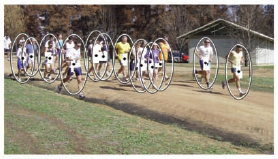TR2008-037
Pedestrian Detection Via Classification on Riemannian Manifolds
-
- , "Pedestrian Detection via Classification on Riemannian Manifolds", IEEE Transactions on Pattern Analysis and Machine Intelligence, Vol. 30, No. 10, pp. 1713-1727, October 2008.BibTeX TR2008-037 PDF
- @article{Tuzel2008oct,
- author = {Tuzel, O. and Porikli, F. and Meer, P.},
- title = {{Pedestrian Detection via Classification on Riemannian Manifolds}},
- journal = {IEEE Transactions on Pattern Analysis and Machine Intelligence},
- year = 2008,
- volume = 30,
- number = 10,
- pages = {1713--1727},
- month = oct,
- issn = {0162-8828},
- url = {https://www.merl.com/publications/TR2008-037}
- }
- , "Pedestrian Detection via Classification on Riemannian Manifolds", IEEE Transactions on Pattern Analysis and Machine Intelligence, Vol. 30, No. 10, pp. 1713-1727, October 2008.
-
Research Areas:

Abstract:
We present a new algorithm to detect pedestrians in still images utilizing covariance matrices as object descriptors. Since the descriptors do not form a vector space, well-known machine learning techniques are not well suited to learn the classifiers. The space of d-dimensional nonsingular covariance matrices can be represented as a connected Riemannian manifold. The main contribution of the paper is a novel approach for classifying points lying on a connected Riemannian manifold using the geometry of the space. The algorithm is tested on the INRIA and DaimlerChrysler pedestrian data sets where superior detection rates are observed over the previous approaches.
Related News & Events
-
NEWS IEEE Transactions on Pattern Analysis and Machine Intelligence: publication by Oncel Tuzel and others Date: October 15, 2008
Where: IEEE Transactions on Pattern Analysis and Machine Intelligence
Research Area: Machine LearningBrief- The article "Pedestrian Detection via Classification on Riemannian Manifolds" by Tuzel, O., Porikli, F. and Meer, P. was published in IEEE Transactions on Pattern Analysis and Machine Intelligence.